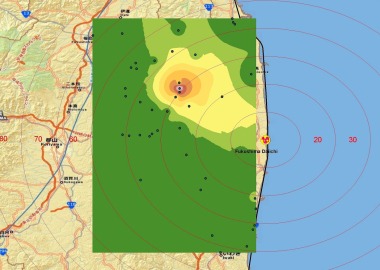Fukushima moved to Level 7
12 April 2011
The ongoing radiological release from the Fukushima Daiichi nuclear power plant has led Japanese authorities to raise the rating of the accident there to Level 7.
A batch of eight safety-related incidents were recorded on the International Nuclear Event Scale (INES) in the days after a 14-metre tsunami left the site flooded to a level of over five metres.
Covering both the Fukushima Daiichi and Daiini plants, these concerned the overall effect on the nuclear plants (Level 3), two losses of cooling function (Level 5), one covering radiological release (Level 5), one on loss of cooling to a fuel pond (Level 3) and three more on loss of reactor cooling (Level 3).
These have now been supplemented by an additional rating at the top Level 7, 'a major accident'. Japanese authorities notified the International Atomic Energy Agency of their decision to up the rating: "As a result of re-evaluation, total amount of discharged iodine-131 is estimated at 1.3x1017 becquerels, and caesium-137 is estimated at 6.1x1015 becquerels. Hence the Nuclear and Industrial Safety Agency has concluded that the rating of the accident would be equivalent of Level 7."
 |
This map from the International Atomic Energy Agency shows Iiata
village as the only place to have received any notable disposition
of radionuclides
|
The only other accident ever put at this level was the explosion and sustained fire at Chernobyl 4 in April 1986. This, however, was made far worse in terms of health impact by the instantaneous nature of the release, the failure of authorities in the Soviet Union to evacuate nearby people and restrict the consumption of milk and finally by some people's refusal to take potassium iodide tablets due to mistrust of the government.
By comparison at Fukushima the situation developed over a number of days giving Japanese authorities ample time to evacuate residents living within 20 kilometres and warn those in a further ten kilometre radius to stay indoors. Milk, drinking water and many other foodstuffs have been routinely monitored and their consumption controlled. Potassium iodide tablets were distributed early and consumed at the right time.
A series of radiological releases have taken place from the plant. The most serious for people took place to the air around 15 March, five days after the tsunami triggered the emergency situation. Since then radiation releases have in general trended downwards, with some lesser spikes on site due to various events in the work to control the situation.
Radioactive releases to sea are now also decreasing since Tokyo Electric Power Company identified and plugged the place from which highly contaminated water was leaking directly to sea. At the same time the company has released a larger amount of much less contaminated water to free space in a waste management facility on site to store the more contaminated water.
One concern for Japanese authorities is the higher disposition of radionuclides in the village of Iiate, about 30 kilometres northwest from Fukushima Daiichi and outside the evacuation zone. The reason for the higher rate of contamination in that localised area is not known, but monitoring has shown it to be the only area significantly affected by the accident.
So far, three workers have been killed by the immediate effects of the earthquake and tsunami and none by the effects of radiation. No measurable effect on the general public is expected.
Researched and written
by World Nuclear News